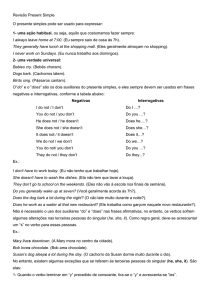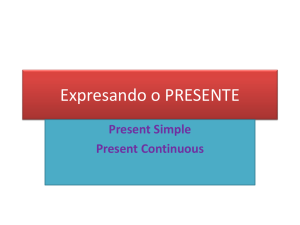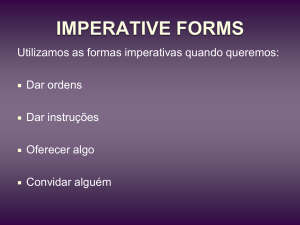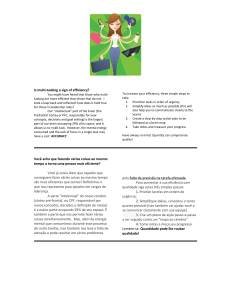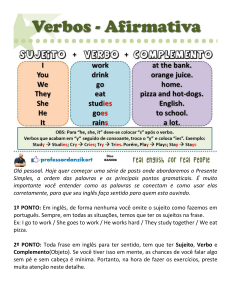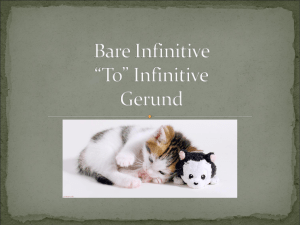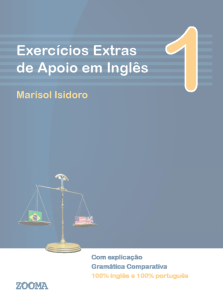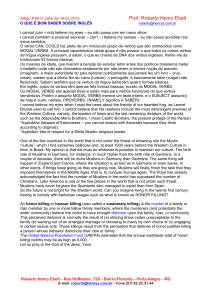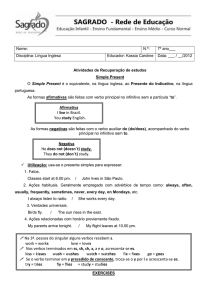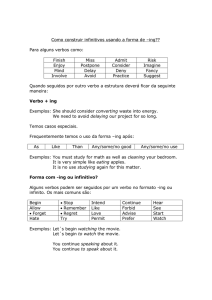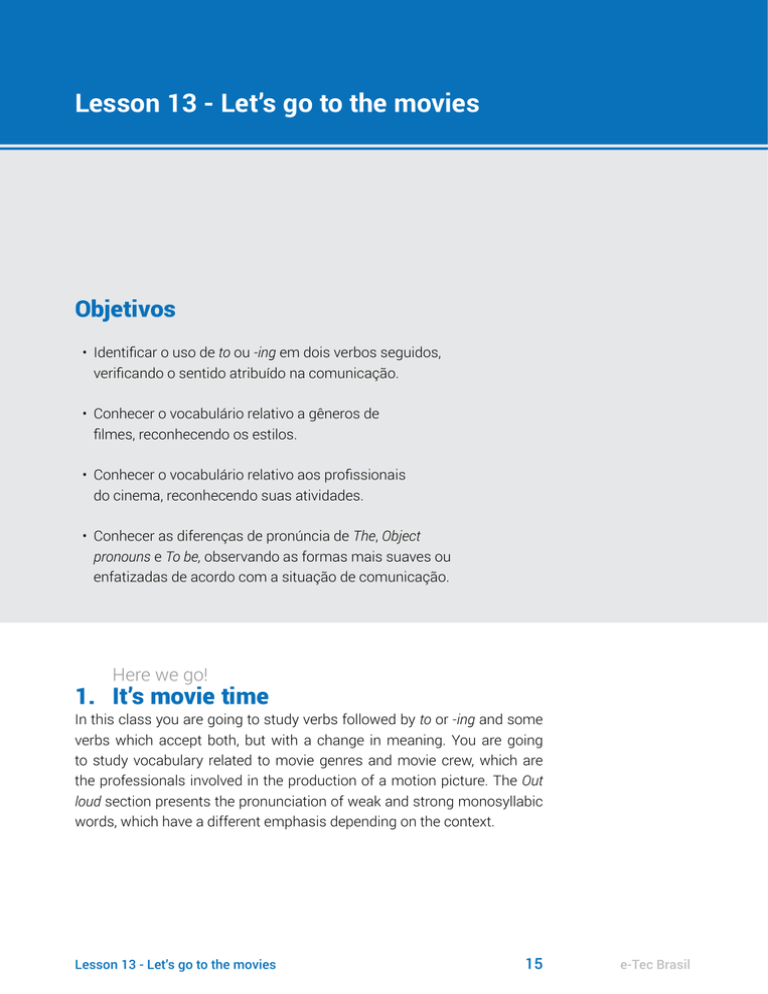
Lesson 13 - Let’s go to the movies
Objetivos
• Identificar o uso de to ou -ing em dois verbos seguidos,
verificando o sentido atribuído na comunicação.
• Conhecer o vocabulário relativo a gêneros de
filmes, reconhecendo os estilos.
• Conhecer o vocabulário relativo aos profissionais
do cinema, reconhecendo suas atividades.
• Conhecer as diferenças de pronúncia de The, Object
pronouns e To be, observando as formas mais suaves ou
enfatizadas de acordo com a situação de comunicação.
Here we go!
1. It’s movie time
In this class you are going to study verbs followed by to or -ing and some
verbs which accept both, but with a change in meaning. You are going
to study vocabulary related to movie genres and movie crew, which are
the professionals involved in the production of a motion picture. The Out
loud section presents the pronunciation of weak and strong monosyllabic
words, which have a different emphasis depending on the context.
Lesson 13 - Let’s go to the movies
15
e-Tec Brasil
Warming up
2. I wanna go to a real movie theater!
In this episode Regan is a little upset, because she doesn’t want to watch
a movie sitting on a coffin at the Funeral Home. The problem is that Chuck
can’t afford taking her to the movies, so they end up having an argument.
Read and listen to their conversation:
Regan: Gee, Chuck, when are you gonna stop being so stingy and take me to a
real movie theater?
Chuck: My bad, Regan. I know you deserve much more than this, but you know I'm broke.
Integrated media
Acesse o conteúdo I wanna go to
a real movie theater! e acompanhe
a conversa entre Regan e Chuck.
Regan: But I really enjoy going to the movies!
Chuck: I know, and I can't stand seeing you so sad. You really deserve to have a decent
night out. When all of this is over, we'll have enough money to do whatever we want.
Regan: Yeah, sure. Let's just keep watching.
Glossary
Stingy: not generous
in terms of money
Broke: without any money
Learning activity
Movie section
e-Tec Brasil
Regan and Chuck have an argument because they are watching an action
movie in the Funeral Home, and she would rather go to the movies. Perhaps
she would also like to watch a more girly movie, not so full of action and
motorcycles. Exercise your comprehension of the dialogue between Regan
and Chuck in the learning activity Movie Section.
In the following topic you are going to study the vocabulary related to
movie genres.
16
English
3. Getting the hang of it
3.1 Main movie genres
Regan and Chuck estão na casa funerária, assistindo um action movie. Este
tipo de filme frequentemente inclui explosions, fights, stunts and chases, e
geralmente mostram a batalha entre heróis e vilões. Acompanhe na tabela
a seguir a descrição de alguns tipos de filmes:
Romantic
It is a funny story with a happy ending. This type of film
often explores love at first sight and all kinds of love, and
serves as an escape for the audience. The development of
the plot leads to the always desired “Happily ever after”.
Animation
Cartoon
It is made from individual drawings, illustrations or
paintings, which are photographed frame by frame. The
final product is a rapid display of a sequence of static
images, different from each other in imperceptible details.
Science fiction
Sci-fi
It often explores philosophical issues or focuses
on social or political issues. It uses special effects
and depicts ETs, time travel and other phenomena
not fully accepted by mainstream science.
Horror
It grabs the viewer’s attention by invoking their worst
fears. The plot includes monsters and deranged humans,
combining entertainment and cathartic experiences,
with an often shocking and terrifying finale.
Comedy
Aiming to amuse and make the audience laugh,
comedy movies exaggerate ordinary situations.
One type of comedy that people are keen on is the
slapstick, a kind of film where physical activity is
involved, exceeding the limits of common sense.
Lesson 13 - Let’s go to the movies
17
Audio
e-Tec Brasil
Drama
Dramatic themes, such as moral dilemmas, drug addiction,
infidelity or violence, among others, are the central
themes. Characters are in conflict at a crucial moment
in their lives, and they must overcome tragic crises.
Documentary
A factual record or report about real people and events.
Suspense
Thriller
The plot keeps you “on the edge of your seat”.
It is adrenaline-rushing and fast-paced, and
provides the viewer a rush of emotions, like a high
level of anxiety, surprise and expectation.
Adventure
It often depicts treasure hunts, searches or
expeditions for lost continents. Adventure movies
are full of adrenaline and excitement.
Chick-flick
Intended especially for women, a chick-flick deals
with love and romance. The plot is often filled with
heavy emotions and relationship-based themes.
War
It often pairs with action, adventure or romance. This type
of movie may depict daily military or civilian life during the
war, but most frequent it is about naval, air or land battles.
Western
One of the oldest kinds of film. It combines dusty
towns, cowboys and Indians to tell the story of
the early days of American expansion.
Audio
Getting on
Acesse a mídia Go to the
movies e explore o vocabulário
relacionado ao cinema.
Learning activity
Movies and their genres
What is this about?
e-Tec Brasil
Conhecer este vocabulário permite que você consiga manifestar suas
preferências sobre o estilo de filme que você mais gosta. Pratique este
vocabulário com as atividades Movies and their genres e What is this about?
No tópico a seguir você estudará o vocabulário referente aos profissionais
envolvidos em uma produção cinematográfica.
18
English
3.2 Movie Crew
Para produzir um filme, muitos profissionais são envolvidos, desde a
criação do enredo até a edição. Acompanhe a seguir a descrição de cada
uma dessas atividades:
Actor
Actress
The person who acts in a movie, play, soap opera, etc.
Main actor
Main actress
The actor or actress who plays the most
important role of the movie.
Supporting actor
Supporting actress
The actor or actress who plays any important
role in the movie but not the main one.
They’re usually known as ‘antagonist’.
Producer
The person who supervises the production of a
movie and controls the budget or the finances.
Director
The person who directs and instructs the actors
and the crew in a movie production.
Screen writer
The person who writes the script for
a movie (the screenplay).
Camera man
The person who operates a movie camera.
Make-up artist
The artist responsible for the make-ups of the actors.
Costume designer
The person who is responsible to create or
design the costumes used in a movie.
Stunt person
The person who replaces the actors in dangerous
scenes. You can also use the terms stunt man and stunt
woman when you know the gender of the person.
Editor
The person who makes a selection of the shots of a movie
and constructs the flowing sequence of the images.
Handyman
The person who is responsible for the maintenance
of the equipment used in the movie production.
Depois de estudar o que cada profissional desempenha, pratique este
vocabulário com as atividades Movie Crew - who is who? e Movie review. No
tópico a seguir você estudará quais verbos são seguidos da partícula de
infinitivo to, os seguidos da forma gerúndio -ing e algumas exceções que
aceitam as duas possibilidades.
Lesson 13 - Let’s go to the movies
19
Audio
Learning activity
Movie Crew - who is who?
Movie review.
e-Tec Brasil
3.3 Verbs followed by to or -ing
No episódio desta aula, Regan e Chuck estão assistindo um filme na
Funeral Home. Regan pergunta ao namorado quando ele vai deixar de
ser tão mesquinho e levá-la ao cinema. Veja o que Chuck responde,
tentando se desculpar:
You really deserve to have a decent night out.
Mind the gap
Os verbos modais são seguidos
de verbos sem a partícula
to ou a terminação -ing.
No caso destes verbos serem
seguidos por um substantivo,
não há modificação, pois
substantivos não são conjugáveis.
Getting on
Para lembrar a diferença
entre o uso do to ou -ing
em verbos. Acesse-os em
Verbs of liking and disliking.
e-Tec Brasil
Perceba que Chuck utiliza o verbo deserve, seguido do verbo have
acompanhado da partícula to. Quando temos dois verbos, um seguido de
outro, o segundo verbo pode estar na forma infinitiva com a partícula to ou
acrescido da terminação -ing. Na Lesson 11 do módulo 01, você estudou
os verbs of liking and disliking, e a sutil diferença que existe entre o uso de
to ou -ing após cada um deles.
Verbos seguidos de to ou -ing exigem, a princípio, memorização. Não há
regras quanto ao uso da partícula de infinitivo ou o gerúndio, por isso é
importante que você memorize os verbos apresentados nesta aula. Com a
prática, a tendência é que você lembre mais facilmente.
20
English
Veja na tabela a seguir os exemplos de verbos seguidos da partícula to.
Observe que o uso desta partícula independe do tempo verbal no qual
estão conjugados:
Audio
Verbs followed by the infinitive particle to
Verbs
Examples
agree
He didn’t agree to spend money on a chick-flick movie.
choose
Carlton chose to say goodbye to his
father on a mountain top.
decide
I’ve decided to stay here longer.
deserve
Regan deserves to go to a real movie theater.
hope
They hope to find the truth soon.
prefer
I’m sure she’ll prefer to watch a romantic comedy.
pretend
Sarah pretended to be someone she’s not.
want
I want to have an autograph from the main actress.
Acompanhe alguns exemplos de verbos que exigem a terminação -ing nos
verbos que os seguem:
Verbs followed by gerund
Verbs
Examples
avoid
Avoid leaving your children unattended at the movies.
can’t stand
I can’t stand watching dubbed movies.
consider
Chuck should consider finding a job.
deny
My neighbor totally denied breaking my vase.
enjoy
Jason enjoys working as a stunt man.
finish
Have you finished editing that animation?
mind
I don’t mind waiting until Friday for the premiere.
quit
The doctor said he must quit acting.
resist
I just never resist buying war movies.
Lesson 13 - Let’s go to the movies
Mind the gap
21
Can’t stand someone/something
é uma expressão que não
pode ser alterada, ou seja,
não pode ser conjugada
em outro tempo verbal.
e-Tec Brasil
Audio
Existem alguns que aceitam tanto a partícula de infinitivo to como a
terminação -ing nos verbos que os seguem. Veja novamente a frase dita
por Regan enquanto assistia a um filme com Chuck:
Gee, Chuck, when are you gonna stop being so stingy
and take me to a real movie theater?
Perceba que na frase foi utilizado o verbo stop, seguido do verbo be + -ing. O
verbo to stop é um exemplo de verbo que aceita tanto a partícula to quanto
a terminação -ing no verbo seguinte. No entanto, é preciso estar atento
ao que se pretende dizer: utilizar to ou -ing resulta em uma diferença de
sentido da frase. Ao dizer stop being so stingy, Regan está dizendo “parar
de ser mesquinho”, e se dissesse stop to be so stingy, ela estaria dizendo
“parar para ser mesquinho”. Com isso, Regan só poderia ter dito stop being.
Observe a seguir outros exemplos de verbos que aceitam tanto a
preposição to como a terminação -ing, e perceba a diferença de sentido
entre as frases:
Dread
She dreaded traveling by plane.
A forma gerúndio após dread indica recear, ter medo de alguma
coisa no âmbito geral. “Ela teve medo de viajar de avião.”
e-Tec Brasil
22
English
He dreaded to think what could happen.
Dread é muitas vezes utilizado com think ou consider. Nessa
frase, dreaded to think significa que He didn’t want to think, ou
seja, “Ele teve medo de pensar o que poderia acontecer.”
Audio
Try
She tried buying it online, but she had no internet signal
Try + gerúndio significa tentar, experimentar, utilizando diferentes métodos para
que algo dê certo. “Ela tentou comprar online, mas não tinha sinal de internet.”
She tried drinking the milk, but it was sour.
Try + gerúndio também é utilizado quando experimentamos alguma
coisa, mas não gostamos nem temos intenção de experimentar
novamente. “Ela tentou beber o leite, mas estava azedo.”
She tried to fix the TV, but she just made the problem worse.
Nessa frase, utilizou-se o infinitivo porque ela não obteve sucesso ao tentar
consertar a televisão. “Ela tentou consertar a TV, mas só piorou o problema.”
Try not to disturb me, I have to finish this by 6 o’clock.
O infinitivo também é utilizado se você pede algo que alguém pode ou não
conseguir fazer. “Tente não me perturbar, preciso terminar isto até às seis horas.”
Begin
She began dancing.
She began to dance.
Quando begin está conjugado em um tempo verbal simples (Present,
Past, Present Perfect ou Future Simple), pode-se utilizar tanto
o infinitivo quanto o gerúndio. “Ela começou a dançar.”
She is beginning to dance.
Quando begin está conjugado em um tempo verbal contínuo, o verbo
seguinte fica no infinitivo. “Ela está começando a dançar.”
Regret
I don’t regret saying this.
Regret é geralmente utilizado com gerúndio. “Eu não me arrependo de dizer isto.”
Lesson 13 - Let’s go to the movies
23
e-Tec Brasil
We regret to inform you that your letter has been rejected.
Audio
We regret to inform you (...) é uma expressão formal e bastante utilizada, por
exemplo, em cartas enviadas por universidades a estudantes. Significa We wish
we did not have to tell you (...). Nesse caso, regret é seguido do verbo inform com
a partícula de infinitivo to. “Lamentamos informar que sua carta foi rejeitada.”
Start
Marge started screaming
during the horror movie.
Marge started to scream
during the horror movie.
Quando start está conjugado em tempos verbais simples (Present, Past,
Present Perfect ou Future Simple), pode-se utilizar tanto o infinitivo quanto
o gerúndio. “Marge começou a gritar durante o filme de terror.”
Marge is starting to scream again.
Quando start está conjugado em um tempo verbal contínuo, o verbo seguinte
só poderá estar no infinitivo. “Marge está começando a gritar novamente.”
I started to study Japanese, but it was so difficult that I quit the classes.
Para expressar que não foi possível completar ou continuar
uma atividade, utiliza-se infinitivo após o verbo start. “Comecei
a estudar japonês, mas foi tão difícil que parei as aulas.”
Remember
I remember writing the message on a piece of paper .
Remember, quando utilizado com um gerúndio, significa que alguém se lembrou
de ter feito algo. “Lembro ter escrito a mensagem num pedaço de papel.”
Fortunately, he remembered to turn off the gas before he left.
Quando remember é utilizado com o infinitivo, significa que alguém lembrou que
precisa fazer algo. “Felizmente, ele se lembrou de desligar o gás antes de sair.”
Forget
She forgot having nightmares when she was a kid.
Quando forget é utilizado com o gerúndio, significa esquecerse de ter feito algo ou passado por alguma situação. “Ela
esqueceu que teve pesadelos quando era criança.”
e-Tec Brasil
24
English
She forgot to pay the rent this month.
Quando forget é utilizado com o infinitivo, significa esquecer-se que é
preciso fazer algo. “Ela se esqueceu de pagar o aluguel este mês.”
Audio
Com este conteúdo é possível compreender a diferença entre o uso da
partícula to ou a terminação -ing após os verbos apresentados. Verifique
sua aprendizagem realizando as atividades Talking about Preferences e
Sentence meaning. No tópico a seguir você estudará a ênfase em palavras
monossilábicas para que você consiga aperfeiçoar seu speaking.
Learning activity
Talking about Preferences
Sentence meaning
Out loud
3.4 Weak and strong monosyllabic words
Em língua inglesa, é comum palavras monossilábicas terem sua
pronúncia mais suavizada ou mais enfatizada, dependendo da função que
desempenham na frase.
Com o artigo the, por exemplo, a forma suavizada é mais comum, pois
ele frequentemente não carrega muito significado na oralidade. O artigo
definido the é enfatizado apenas quando queremos dizer que algo é
especial. Escute as frases e perceba a diferença:
Weak
Strong
I found the document last night.
I found the document last night.
Os Object pronouns e o verbo To be também são strong quando queremos
enfatizá-los onde estão inseridos. Escute as frases e perceba a diferença:
Weak
Strong
Do you like him?
I don’t like him. I like her.
Come with us to the movies tomorrow.
Sorry, I don’t wanna go with
you. I wanna go with them.
I’m not paid for this.
Yes, you are!
I was at home yesterday.
I was at home yesterday. I’m not lying!
Lesson 13 - Let’s go to the movies
25
e-Tec Brasil
Learning activity
Strong or weak sound?
Estudar as diferenças de pronúncia do artigo definido the, dos Object
pronouns e também do verbo To be nas formas mais suaves ou enfatizadas
dependendo do contexto possibilitam que você pronuncie as palavras de
maneira adequada. Para tanto, pratique este conteúdo com a atividade
Strong or weak sound?
Catching a glimpse
4. Canadian movie ratings
Integrated media
Acesse a mídia Canadian movie
ratings para escutar este texto.
Movies are made to entertain, inform or even promote discussions about
important issues. Some are destined for children, others for adults. Each
country has a system that controls what can be watched by people
according to their ages.
So, if you are planning to go to the movies in Canada, pay attention to the
movie ratings system:
• G: stands for General Audience, meaning that the movie can be seen by
people of all ages.
• PG: stands for Parental Guidance. It means the film has no age restriction
but some scenes may not be suitable for all children.
• 14A: (14 Accompaniment) - in this category, people under the age of 14
must be accompanied by an adult.
e-Tec Brasil
26
English
• 18A: (18 Accompaniment) - this rating indicates that the movie can
be watched by people over 18 years old. People under 18 and over 14
must be accompanied by an adult. People under 14 are not allowed.
• R: stands for Restricted, which means that only people at the age of 18
or older can watch this kind of film.
• A: stands for Adult. It corresponds to X-rated movies in the USA. In
Canada, an A-rated movie is restricted to people who are 18 or older.
A-rated movies usually contain violence or sex scenes.
Some Canadian cities have their own rating system, but most of them
follow these categories. Next time you decide to watch a movie, take a look
at the rating symbol. It will help you avoid embarrassing situations, mainly
when there are children with you.
5. That’s a wrap
In this class you watched Chuck talking about money problems and Regan
complaining that they never go to the movies. Based on this situation,
you studied the verbs that can only be followed by to or -ing, and some
that accept both but with a difference in meaning. After that, you studied
the most common movie genres and their description, as well as the
professionals involved in a movie production. In the Out loud section
you studied that some monosyllabic words have either a weak or strong
pronunciation, depending on the context. Finally, you read a text about the
Movie Rating system in Canada so that you can watch the appropriate film
with friends and family. Hope you had fun, good luck in the next lesson!
Lesson 13 - Let’s go to the movies
27
e-Tec Brasil
e-Tec Brasil
28
English

